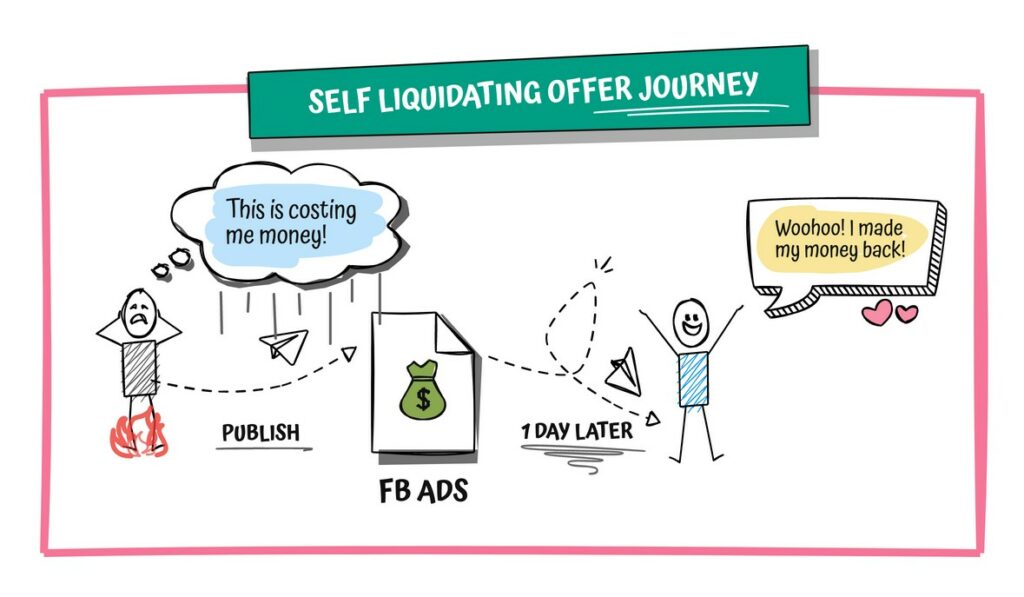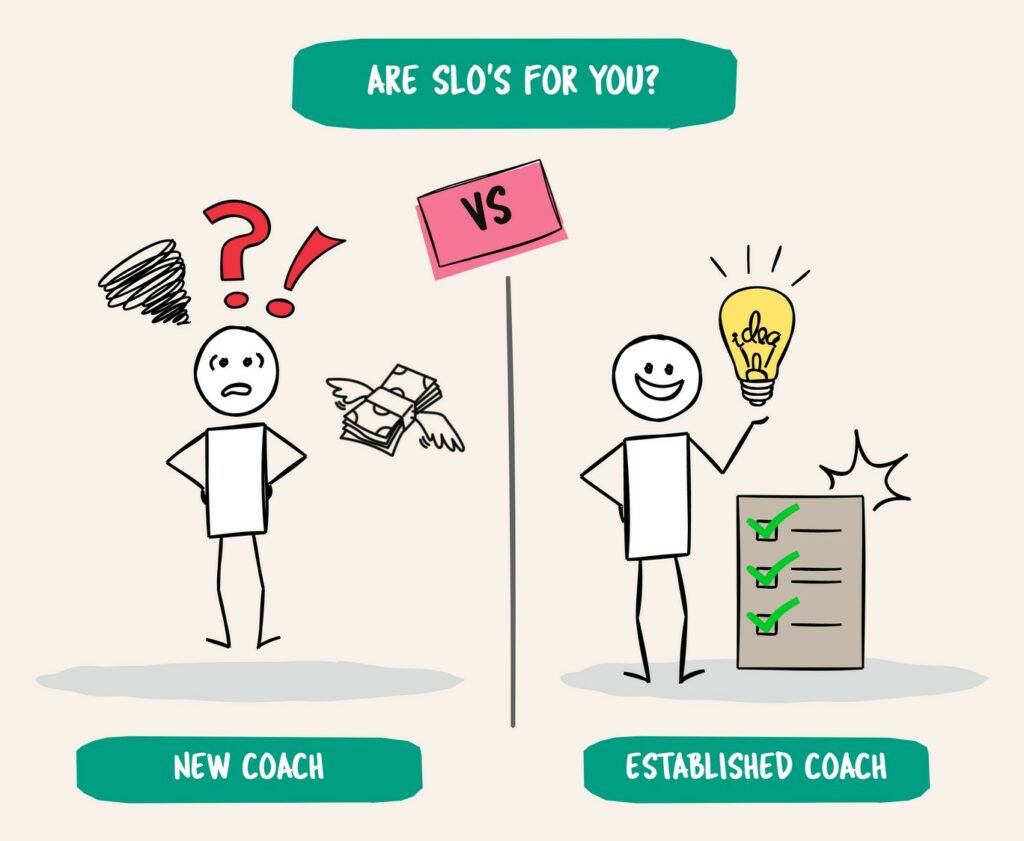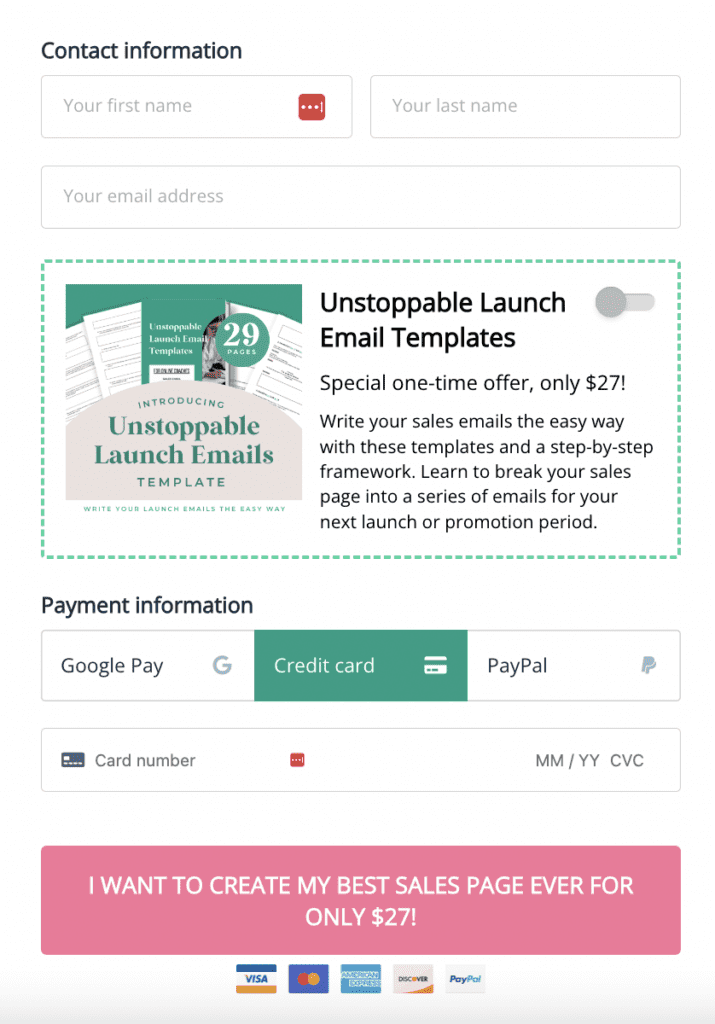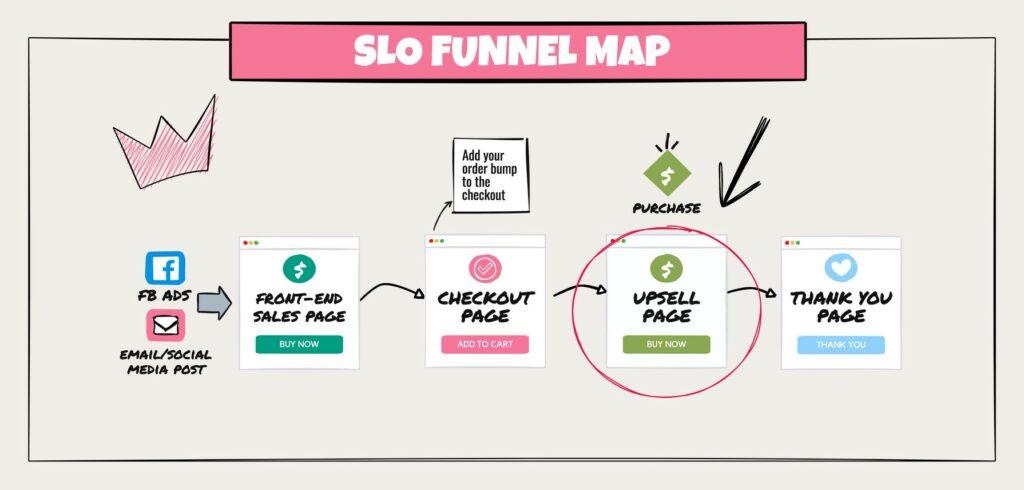Look, 2025 is flooded with all sorts of crazy marketing strategies you could use to boost your coaching business. Honestly, it can be an absolute headache trying to pick the one that fits just right.
Now, right in the middle of this marketing madness is this thing called a Self Liquidating Offer funnel, or just SLO for short. These bad boys have been turning heads and racking up popularity points in recent years. You’ve probably heard about them.
So, I thought I’d do you a favor and break them down for you.
We’re going to delve into what these SLOs really are, how to use them in your own business, and figure out if using one is the right decision for where you’re at in your business journey right now.
Hang tight, because it’s going to be a SLO ride! 🤣
What is a self liquidating offer?
Let’s get started: what on earth is a self-liquidating offer? Or as the cool kids call them; an SLO.
Hit up Google and search “self-liquidating,” and you’ll find a definition like this: “An asset that earns back its original cost out of income over a fixed period.” In layman’s terms, that’s something you buy that pays for itself over time.
But we’re not talking stocks and bonds here, we’re talking about your coaching services. When we say “self-liquidating offers,” we’re referring to those little nuggets that earn you enough to cover the costs of your ad spend. It’s like a little money-recycling system.
Spend $20 on an ad, make $20 from a sale.

Done and dusted.
All this is a swanky way of saying that the money you make from the product is designed to cover, or even exceed, what you forked out to promote it in the first place.
Cool, right?
This concept has been taking the marketing world by storm throughout 2022.
Why?
Well, Facebook ads’ costs skyrocketed thanks to our friend, Apple, shaking things up with some major changes to how Facebook can track people using its products.
You can delve deeper into that rabbit hole right here if this is news to you.
So, in short, SLOs are about turning advertising from an expense into an investment. It’s not just about breaking even, but setting up the first domino in a chain of potential sales. These initial offers might not be your money-makers, but they’re your conversation starters, the enticing starters before the main course of your more expensive products and services.
But keep in mind, it’s not always plain sailing with SLOs, as I’m about to get into.
What an SLO is not! Busting self liquidating offer myths
Over the last couple of years, self-liquidating offers, or SLOs, have stirred up a storm. As many entrepreneurs shout from the rooftops about their transformative potential, it’s easy to get swept up in the hype. But let me tell you, while SLOs can indeed be a potent addition to your marketing arsenal, they’re not the end-all and be-all some folks make them out to be. So, let’s break down a few common myths about SLOs to help set the record straight.
Myth 1: SLOs are Bottomless Wells of Cash
One of the biggest myths I’ve encountered is the notion that SLOs are some sort of perpetual money machines. Sure, if you nail down the perfect offer, master your ad strategy, and build a killer funnel, you could make a pretty penny. But remember, those big figures you see thrown around usually come from what follows the SLO – the high-ticket offers made to the customers who’ve entered your world via the SLO.
Reality Check: Think of SLOs not as your golden goose, but as strategic tools designed for building your email list rapidly and cost-effectively. If they make you some money in the process, consider that a delightful bonus rather than the norm. Remember, they require strategic planning, meticulous testing, and continuous fine-tuning to be successful. While some folks do strike it big with SLOs, it’s important to understand that this isn’t typically the norm — it’s a pleasant exception.
Myth 2: Ad Costs Don’t Dent Your Profit
Often, the success stories you hear about SLOs only tell you half the story. They reveal the impressive top-line figures, but they conveniently forget to mention the ad costs chomping away at those earnings. The fact is, the minute you start running ads, your profits start to dwindle.
Reality Check: It’s crucial to understand that revenue and profit are not the same thing. The costs of your ads can seriously erode your SLO profits, and this needs to be factored into your calculations.
Myth 3: SLOs are a Cinch to Set Up
And then there’s the myth that SLOs are easy to get off the ground. Take it from someone who’s been there and done that – they are not. Setting up an SLO takes patience, a lot of it, and expertise. Or, if you’d rather not pull your hair out than build your own funnels, the budget to hire a pro.
Remember, you’re dealing with three separate products and up to four different email sequences, each linked to various combinations of purchases. It can quickly become a tangled web that’s not so easy to untangle.
Reality Check: SLOs aren’t just another item to tick off your to-do list. They demand technical savvy, meticulous planning, and bucketloads of patience.
Hopefully, busting these myths helps you see SLOs in a clearer light. Yes, they’re a powerful tool to have in your toolkit, but they’re not magic. Like any other marketing strategy, they require careful planning, investment, and ongoing optimization to really deliver.
Now we’ll delve into what you CAN expect from them.
What is the purpose of an SLO funnel?
Alright, now let’s dig into the juicy part: how you, as a coach, can use the power of SLOs to gain new clients AND build that all-important email list at the same time.
Think of SLOs as your marketing magnet. They’re your hook, your bait, the irresistible taster that makes people think, “Wait, there’s more of this goodness? Sign me up!”. Not only do you get a sale from the get-go, but you also get a warm lead to nurture.
The SLO is your opening act, the icebreaker that begins a relationship with potential clients. Once they’ve made the decision to buy, you can keep them engaged with the rest of your content, pulling them further into your sales funnel.
But how does this tie into building your email list?
Well, to get their hands on your SLO, people usually have to provide their email address.
This means every SLO sale equals a new addition to your email list.
When Is an SLO Right for You? Evaluating Your Fit
While Self-Liquidating Offers can be a powerful tool for some businesses, they’re not the one-size-fits-all magic bullet for every coaching practice. It’s important to recognize when they are advantageous and when other strategies might serve you better. So, let’s dive into situations where an SLO might be your best bet and when you should potentially reconsider.

Order bump
This is just a checkbox that the person can tick to add something to their order when they get to the checkout.
1. The SLO Money Spot
If you’re an established coach with a clear understanding of your ideal client and their needs, SLOs can be a game-changer. You’re at a point where you’re ready to scale rapidly, you have a budget for running and testing ads, and you’re ready to put in the time and effort to get things right. When the goal is to grow your audience size quickly and you’re prepared for a bit of trial and error with ads, then SLOs can truly pour fuel onto your growth fire.
2. Reconsidering the SLO Approach
On the other hand, if you’re a new coach still figuring out who your ideal client is and what they want, diving into SLOs might end up being more of a time-suck than a beneficial strategy. Until you’re clear on your client profile and their needs, the effort put into creating and optimizing an SLO may not yield the desired returns.
Similarly, if you’re a one-to-one service provider who doesn’t need a large email list to sustain your business, creating an SLO might not be the best use of your resources. For coaches who can achieve their business goals through a smaller, more intimate client base, focusing on deepening existing relationships might be a more rewarding strategy than expanding the email list.
In essence, it’s all about understanding where you’re at in your business journey and aligning your strategies with your specific goals and circumstances.
As alluring as they might sound, SLOs aren’t always the best fit. Remember, the key to success isn’t finding the ‘perfect’ strategy, but the one that perfectly fits you.
Now let’s dive into the nitty-gritty of what makes up an SLO funnel.
Components of a Great Self-Liquidating Offer Funnel

Front-End Offer: When a potential buyer clicks on your post, email, or Facebook ad promoting your SLO, this is the first offer they’ll see. Successful front-end offers often include bundles of templates or shortcuts for your audience. You want to avoid anything that could be time-consuming, like courses or ebooks. The sweet spot for pricing your front-end offer is anywhere between $7 and $47, aiming for a sales page conversion rate of over 2.5%.
Here’s an example of Funnel Gorgeous’s SLO offer, Offer Cure.
I actually highly recommend this product if you want to create your own SLO but you’re not sure where to start. They show you exactly how to create a high-converting offer and break it down into the core components of the front end, order bump and upsell.
Order Bump: This is a second product presented at the checkout page of the front-end offer. It’s like a surprise bonus that can be added to the basket with a simple click. The key here is to make it valuable or discounted, and it should complement the front-end offer. The price range for the order bump is typically between $17 and $37, with a goal of a conversion rate over 30%.
Here’s an example of what an order bump looks like on the checkout page of one of my own SLO funnels. You can check it out here.

Upsell or One-Time Offer (OTO): This is the grand finale of the funnel, offered after the buyer agrees to purchase the front-end offer. It’s another product that complements the front-end offer but is presented on a separate sales page. The upsell can be priced between $47 – $297, and ideally, you want to aim for a conversion rate of over 10%. This is the perfect spot to offer a course or service to help implement or strategize the front-end product.

Monitoring Your Funnel: Key Metrics at Each Stage
If you’re navigating the SLO funnel waters, there are some key metrics you need to keep your eye on at each stage:
Ad Performance: Monitor click-through rates (CTR) and cost per click (CPC). A high CTR and low CPC is what you’re aiming for.
Front-End Offer Conversion (> 2.5%): Look at how many people who click on your ad actually end up purchasing your SLO. The higher the conversion rate, the better.
Order Bump Conversion (> 30%): Keep tabs on how many customers opt for the order bump. This metric can significantly influence your SLO funnel’s overall profitability.
Upsell Conversion (> 10%): Track how many customers upgrade their purchases with the upsell. Higher conversion rates here can give your profits a good boost.
As you manage your SLO funnel, it’s crucial to monitor these metrics.
By keeping an eye on these numbers, you’ll be able to understand what’s working, what’s not, and adjust your strategy as needed to ensure your SLO funnel is as effective as possible.
After all, knowledge is power and will prevent you from making rash decisions based on the myriad of fears that come up for us when we’re putting offers out into the world.
Mistake 1: Undervaluing the Low-Ticket Products
It’s no secret that your low-ticket products might not be the primary drivers of your revenue. However, that’s no excuse for skimping on the value they provide. It’s a common mistake to underestimate the importance of these products, and consequently, underdeliver.
Here’s why you shouldn’t: a considerable chunk of your potential customers will likely purchase your cheaper products before they even think about making a more significant investment. They’re essentially getting a taste of what you have to offer before they commit further. So if your low-ticket products don’t hit the mark, they might not stick around for more.
Avoiding the Pitfall: Don’t underestimate the value of first impressions. Pour as much effort into your low-ticket products as you would your high-ticket ones. Let your customers see the value you bring to the table from the get-go.
Mistake 2: Failing to Create a Smooth Flow Between Products
An SLO works best when there’s a seamless flow from one product to the next. If the connection between products feels forced or unnatural, it can disrupt the customer’s journey and hinder conversions.
Avoiding the Pitfall: Think of your SLO funnel as a story that’s gradually unfolding. The products should connect naturally, each one leading intuitively to the next. For instance, if your front-end offer is an eBook on blogging, an ideal order bump could be blogging templates for faster writing, followed by an upsell of a course or workshop on SEO for blogging.
Mistake 3: Misalignment between the SLO and the Main Offer
One key element often overlooked is making sure that your SLO is aligned with your main offer (your signature program or more expensive offer). This is crucial because your SLO should attract the right people – those who would be interested in your main offer.
For instance, if you specialize in Instagram marketing and create an SLO revolving around generic social media marketing templates, you might end up attracting folks interested in LinkedIn or Facebook marketing instead of Instagram. It might seem like a minor detail, but getting this wrong could mean missing out on potential clients.
Avoiding the Pitfall: Keep your target audience front and center when crafting your SLO. It should act as a magnet, drawing in those who would genuinely be interested in your main offer. Ensure there’s a clear alignment between what your SLO promises and what your main offer delivers.
Remember, the objective of creating an SLO is not only to offset advertising costs but also to attract the right audience. By avoiding these common mistakes, you can create a more effective SLO, attracting the right clients to your coaching business and setting the stage for long-term success.
Examples of High Converting SLO funnels
In order to really see these in action I’ve included a few examples of some great Self-liquidating Offer Funnels.
Check these out to get a feel for the flow of the front-end offer and order bump. Unfortunately, if you want to see the upsell you’ll need to purchase because the order bump is hidden behind a paywall.
The Ultimate Sales Page Toolkit
Next Steps: Diving Deeper Into Building Your Own SLO Funnel
Embarking on the journey of creating a self-liquidating offer funnel involves a few crucial steps. Here’s a list of what you’ll need, along with some resources that I personally recommend:
- Creating the Offer: This is the starting point. You need a valuable and attractive offer that’s hard for your potential customers to resist. A great resource to help you craft a high-converting offer is the Offer Cure.
- A Funnel Builder: Once you have your offer ready, you’ll need to set it up in a funnel. For this, I suggest Thrivecart. It’s a powerful checkout platform that’s easy to set up and affordable too.
- Email Marketing Tool: You’ll need an email marketing tool for sending out email sequences to your leads. I recommend ActiveCampaign due to its robust features and great deliverability rates.
- A Budget to Run Ads: While the specific amount will depend on your objectives and the size of your audience, you’ll definitely need a budget for running ads to drive traffic to your SLO funnel. Keep an eye out for my recommended Facebook Ads training – link coming soon!
- Tools and Knowledge to Track Data: Tracking and analyzing your data is crucial to the success of your SLO funnel. I highly recommend the Funnel RX training program which provides a comprehensive understanding of funnels and data tracking.
- Confidence to Test and See: Lastly, you’ll need the confidence to test, tweak, and optimize your funnel. This is more about mindset than anything else, and while I don’t have an affiliate link for this, remember that it’s a key aspect of the process. Don’t be afraid to take risks and learn from your mistakes. Remember, the journey towards creating a profitable SLO is often a case of trial and error!
Armed with these resources and a little patience, you’re now ready to take your coaching business to the next level with SLO funnels!
SLO – The Final Verdict
Well, that’s it, my friend! We’ve dug deep into self-liquidating offers, busting a few myths, pointing out some potential trip-ups, and breaking down the art of creating an SLO that really works.
What we’ve figured out is that SLOs can be an absolute game-changer for your coaching business – a way to seriously speed up the growth of your email list while taking some of the sting out of those ad costs.
But they’re not some kind of magical cash generator that works while you kick back and relax. They need a real strategy, a good understanding of your metrics, and, of course, the patience to test, test, and test again.
I’ve done my best to share the facts and some insights from my own experience. Keep in mind, SLOs aren’t the perfect fit for everyone. If you’re a new coach, offering one-on-one services, or you’re still getting a handle on what your ideal clients really want, you might want to hold off on the SLO path for now.
But for those of you who’re ready to really speed up your business growth, and you’ve got the budget and the resilience to really nail your ads, the SLO could be your ticket.
Just remember to keep testing, and above all, keep giving value. Because in the end, that’s what will keep your clients coming back for more.






